Arriving as one of the world’s most expensive players, setting a new club record fee of €127 million at the tender age of just 19 meant that the pressure was always going to be on João Félix once he turned up at Atlético Madrid.
That has certainly been the case, not helped by a dazzling pre-season campaign which sent sky-high expectations into the stratosphere before the Portugal international had even kicked a ball in competitive action.
Since then, it hasn’t been such smooth sailing for Félix.
A stuttering start saw him produce moments of brilliance, but not as regularly as many had hoped for.
As time has gone by, that hasn’t changed.
Atlético fans have been patient with the youngster, but it has not been the sparkling start they may have hoped for.
This tactical analysis will consider just how Félix has settled into life at Atlético Madrid.
The analysis will consider how Atlético’s tactics have affected his introduction to life in La Liga and whether he has the ability to succeed.
A long-term investment, his short-term impact does not mean he won’t reach the heights some hope for, but they have tempered expectations.
João Félix Adaptation
Before analyzing Félix’s performance at Atlético, it is worth mentioning that he will require time to adapt.
As team-mate Hector Herrera has found out, among others, it is challenging to move from Portuguese to Spanish football, and it is far from simple for a young player with limited first-team experience.
Granted, Félix is a remarkable talent, but let’s not forget that when he moved to Atlético in the summer, he still had only 43 first-team appearances at club level and one international cap.
What’s more, getting used to Diego Simeone’s system is often a challenge, particularly for creative offensive players.
As has been seen in cases like that of Thomas Lemar, some simply fail to adjust.
Every player across the field possesses defensive responsibilities and forms part of a rigid set-up when out of possession.
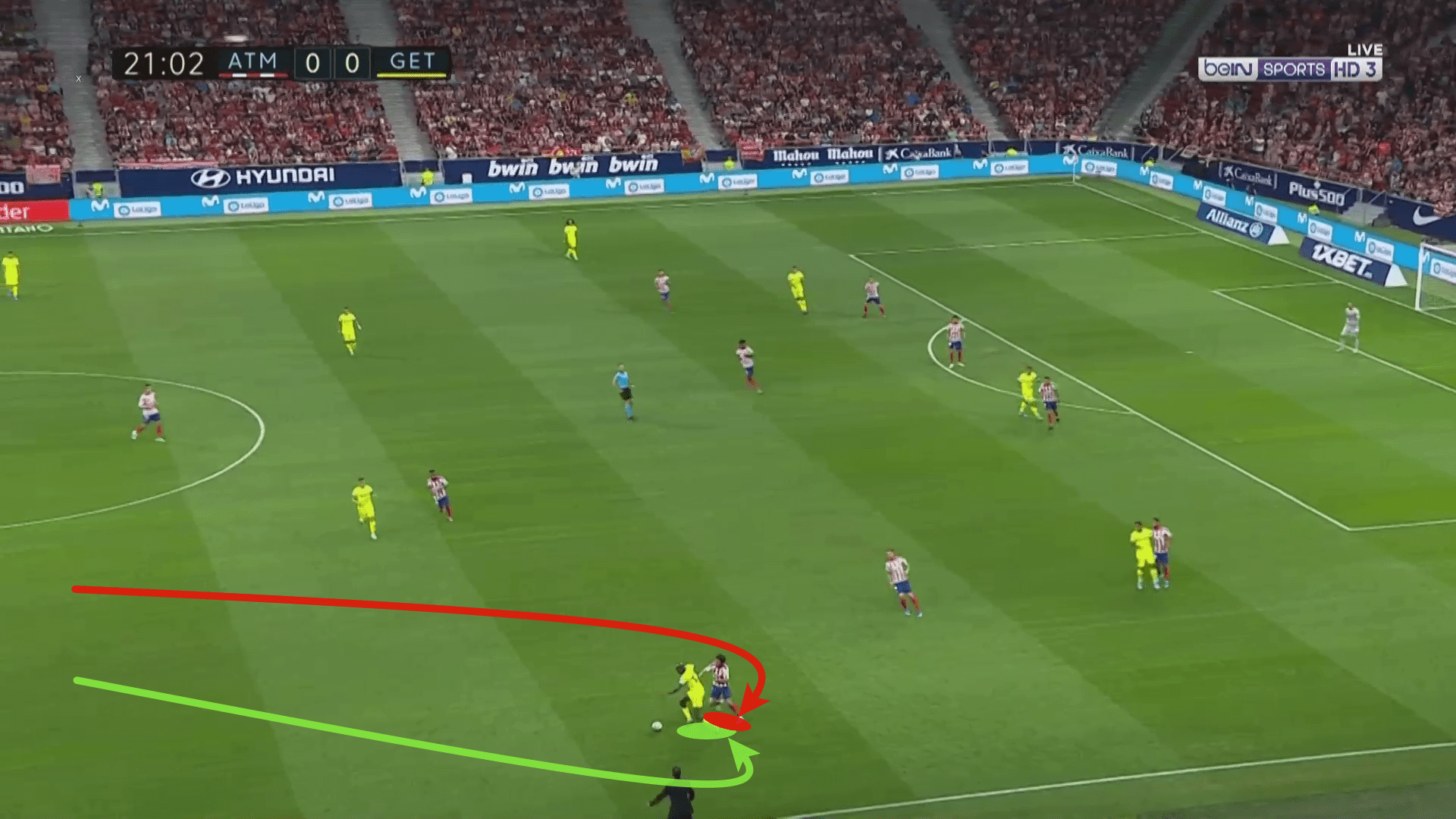
Félix has shown signs that he is adapting well.
Even in his first game, against Getafe shown above, he was keen to be involved defensively.
His work rate could not be questioned.
He tracked back from the front line to prevent the full-back from breaking forward down the flank and exploiting a gap left in the Atleti midfield structure.
As the season has worn on, that has faded slightly.
His total defensive actions have actually decreased compared to last season, from 3.59 per game to 2.87, whilst his success rate has also fallen significantly from 49.3% to 39.7%.
These are perhaps the most concerning statistics as we try to determine whether Félix has what it takes to be a key member of Diego Simeone’s team.
João Félix Style Of Play – Behind the striker
Much has been made of how Simeone has looked to deploy Félix since his arrival.
It is true that he has rarely had one settled position, playing out wide, centrally, and in various roles.
Only Simeone knows whether this is a question of finding the best fit or because he has failed to live up to expectations, but it is undisputable that this constant chopping and changing of his position and role in the side has robbed Félix of the chance to integrate within the team and build up any kind of consistency.
The most comfortable position for Félix is the one that he played in for Benfica.
Here, he operates as a second striker who can drop in to act almost like a number 10 playmaker, with real creative freedom to then burst into the box at the right moment.
One of the key roles which Félix plays here is with his hold-up play, both receiving himself and also interacting with his strike partner as they receive the ball.
When on the ball himself, his role is crucial in the transition.
As can be seen in this example against Barcelona in the build-up play to Koke’s opening goal against the La Liga winners, his hold-up play allows runners to make the move in behind.
As he controls the ball, Álvaro Morata, Ángel Correa and Koke all make runs in behind.
That leaves the two central midfielders forming a triangle with Félix, ready to collect the ball and play a more direct pass over the top into the path of the runners.
These rapidly formed triangles, developed by Félix’s hold-up play and the movement of those around him, help to tear defences apart.
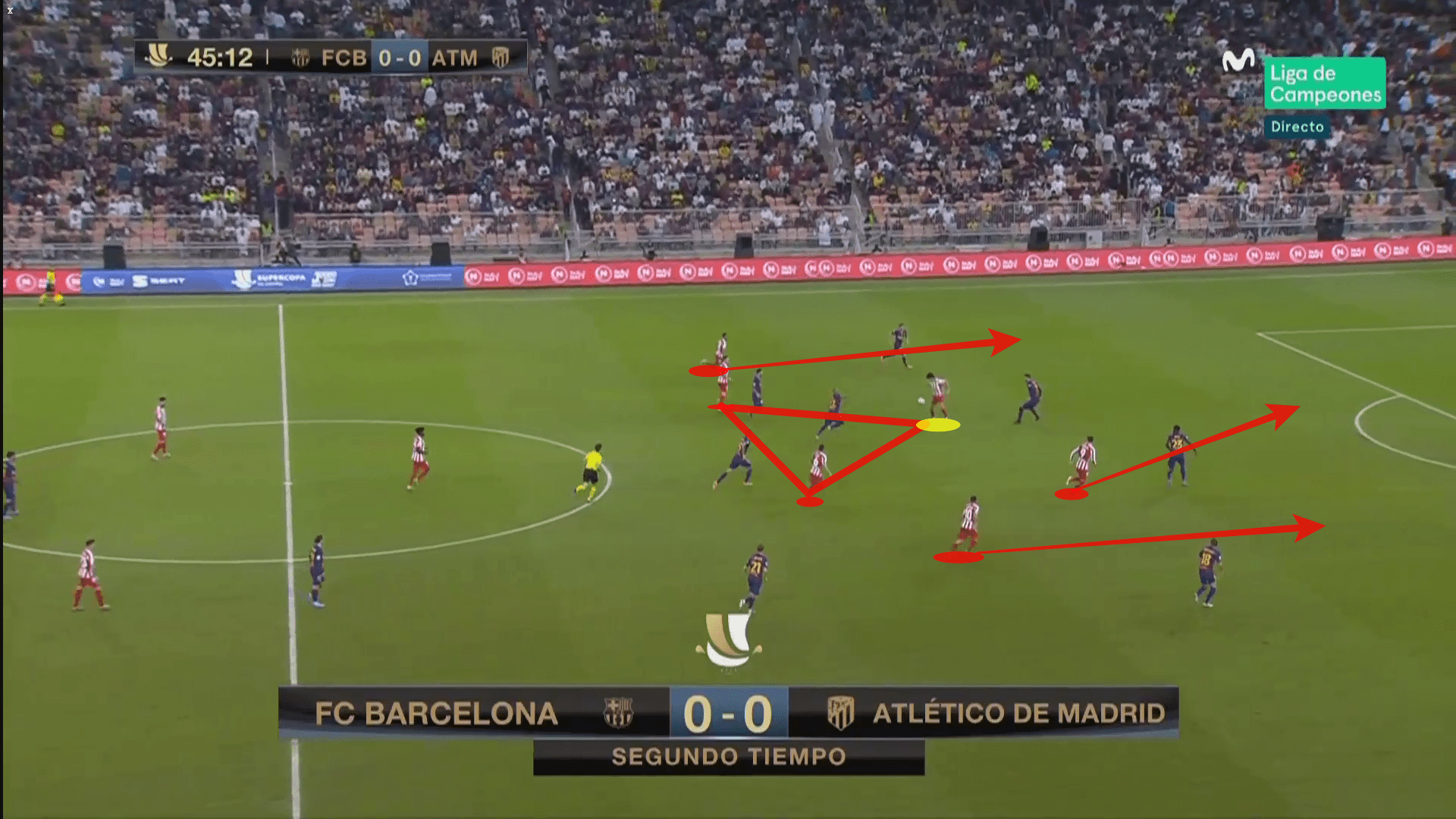
At other times, Félix plays a different role, particularly on the counter.
Rather than holding play up, he will look to play quick passes to keep the move going, something which was particularly prevalent before Diego Costa’s injury, which has ruled him out for most of, if not all, of the season.
Alongside Costa, there was a strong understanding and link-up play between the two.
Costa would carry the physical side of the game, being the clearly identified target man who would take care of the hold-up play.
This was evident in the move against Eibar, which saw Félix score.
He played the ball through to Costa and ran in behind to provide him with the perfect passing option once he made it into the box, allowing him to roll the ball into an empty net.
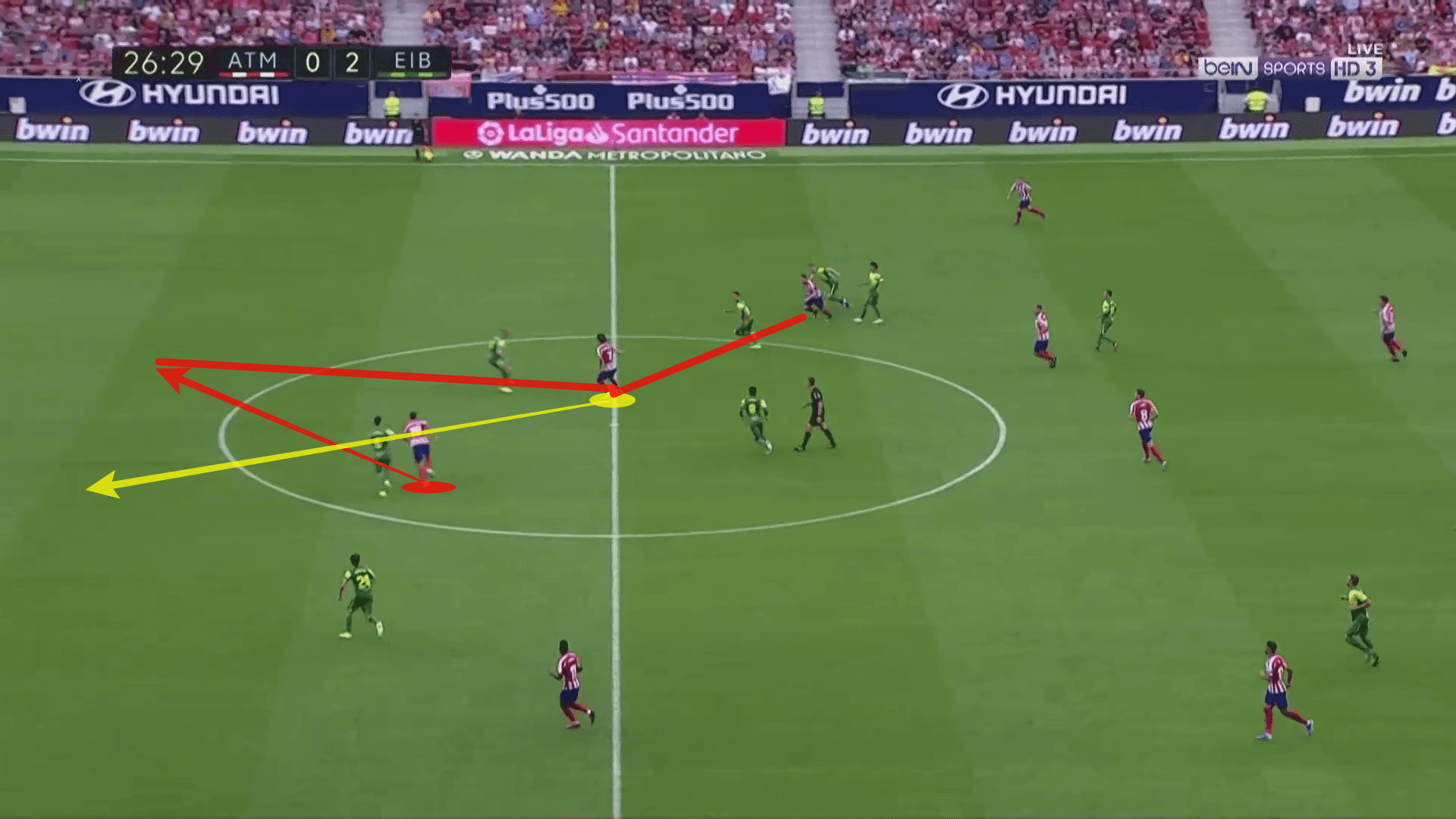
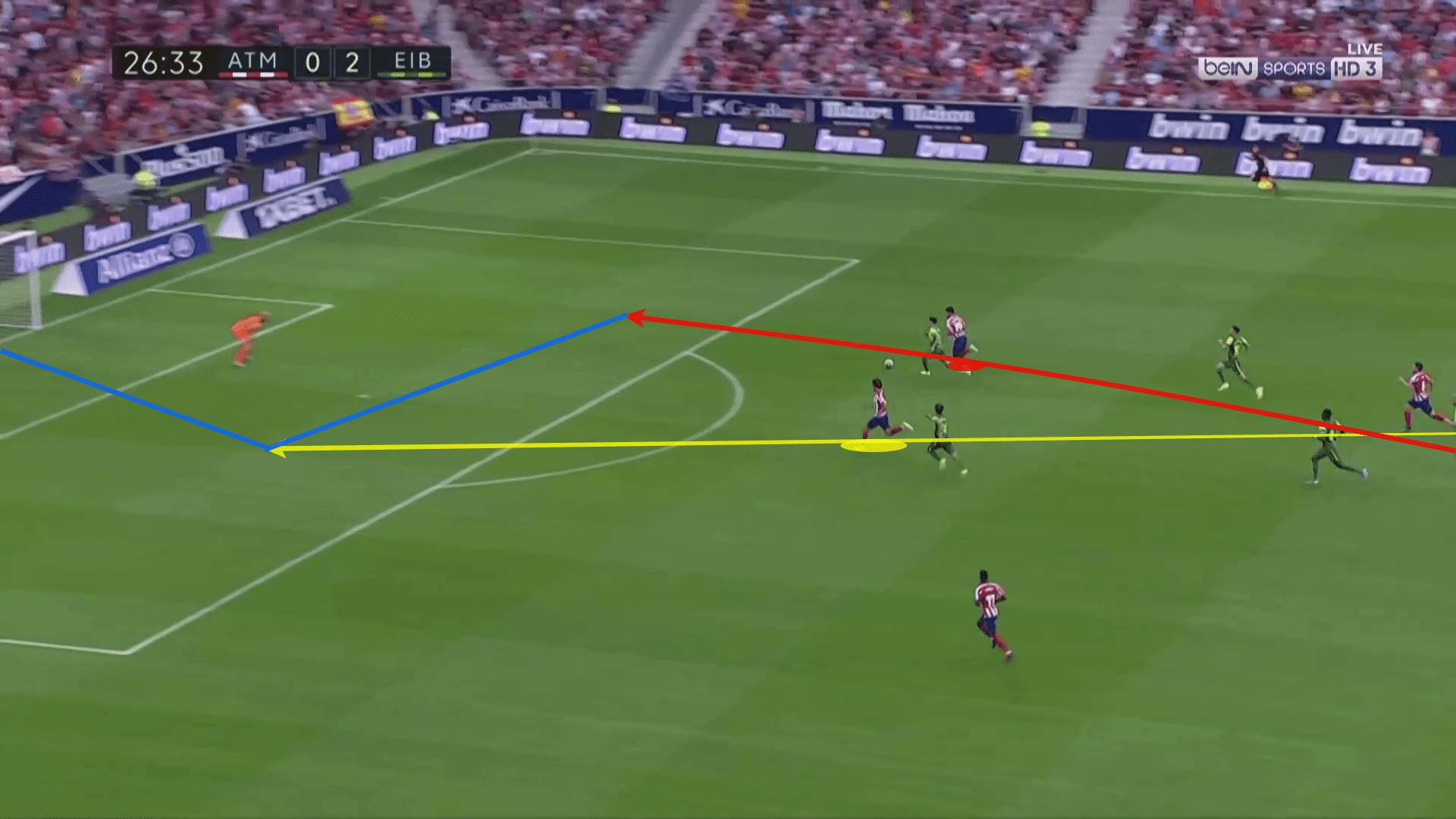
This central role is undoubtedly where Félix is most comfortable.
This is reflected in his dribbles and progressive runs, 4.2 per game and 1.8 per game, respectively, compared to 3.07 per game and 1.02 per game when fielded elsewhere on the field.
This central role gives him greater freedom to roam and allows him to use his technical ability effectively.
It also allows him to drift into wide positions when desired, exploiting gaps in the opposition’s defence and taking on men to come into central roles and attack the final third.
Such freedom is only allowed to one figure in the Atlético team, and that man is Félix regularly.
João Félix Out wide
It may be that having noted how frequently Félix drifted wide, Simeone opted to experiment with him as a wide player, operating as one of the four midfielders.
Simeone’s system operates with a four-man midfield. One player is given license to attack and be more offensive, with the remaining three dropping in to cover and provide a central block.
This is a role that Félix has been given at times, both on the left and the right-hand side.
This is a new role for Félix and it is one which he has struggled to adapt to.
Rather than sticking as a wide player, he is far too often found drifting inside as soon as he receives this ball.
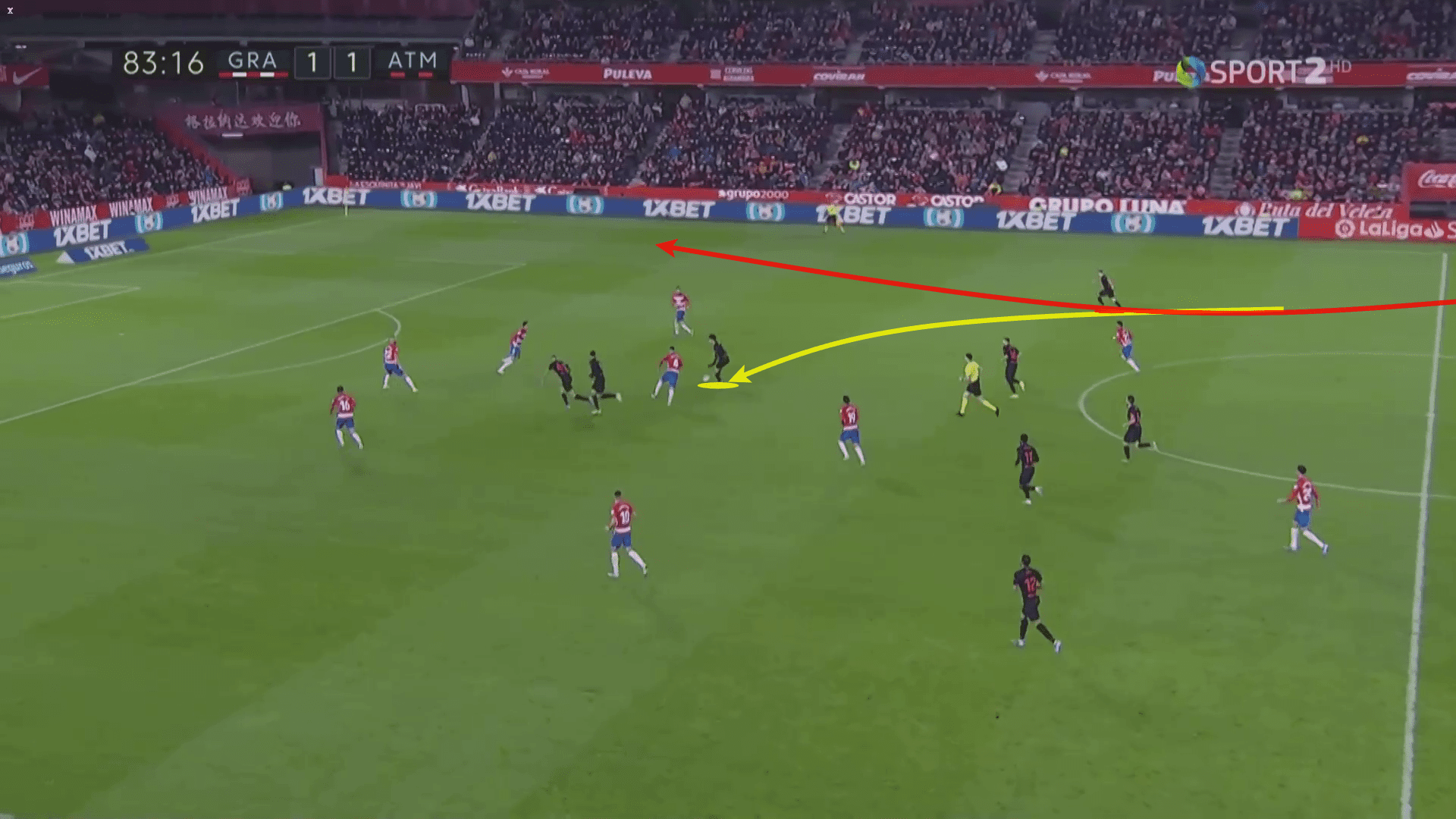
This is not necessarily a bad thing as it does allow him to provide more of a connection with the full-back, whether that be Kieran Trippier or Renan Lodi.
Both offensive-minded players, they can link up with Félix well and exploit the overlapping space well, but are often isolated without support from Félix when going down the channels on their own.
When playing in Simeone’s system, he is encouraged to maintain a wide position as often as possible.
However, it is only when he comes onto the ball that he makes those central runs.
As can be seen in this example against Real Valladolid, Félix positions himself further forward than the other three midfielders, almost operating like a wide player in a 4-3-3 shape rather than as a wide midfielder like the likes of Lemar, Correa, or Saúl play when given this role.
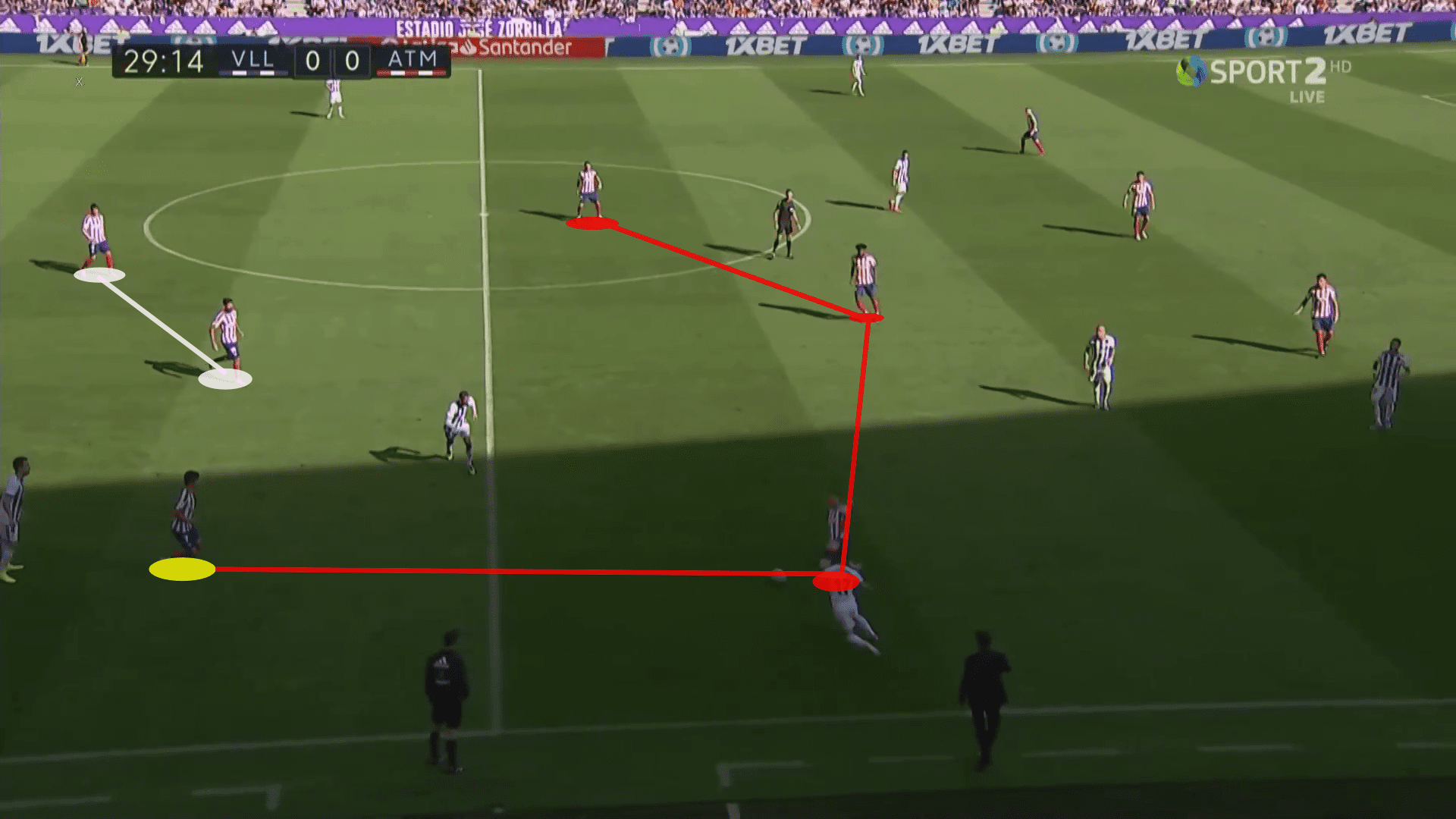
However, it is evident that Félix’s game is restricted in this position.
Whilst he is comfortable in making central runs, his tendency to regularly drift in makes his movement predictable and he can be easily taken out of the game.
Defensively weak and easy to stop in attack, playing him in such a role effectively only serves to limit his impact.
It is clear that in this system, Simeone is looking to fit Félix into his system rather than allowing Félix to shine as he can best.
João Félix Lack of movement
One area of his game that is particularly lacking in consistency and which has been key to his loss of form is his struggle to keep up his impressive movement from his Benfica days.
This can partly be attributed to the structured set-up, which obliges Félix to be more responsible and has less freedom with his movement given his defensive duties.
With this in mind, Félix tends not to gamble on making runs into space when they open up.
Instead, he holds back his runs and is not found breaking the lines as regularly as he was at Benfica.
His more conservative approach is certainly less daring and ambitious but also prevents him from getting into goalscoring opportunities.
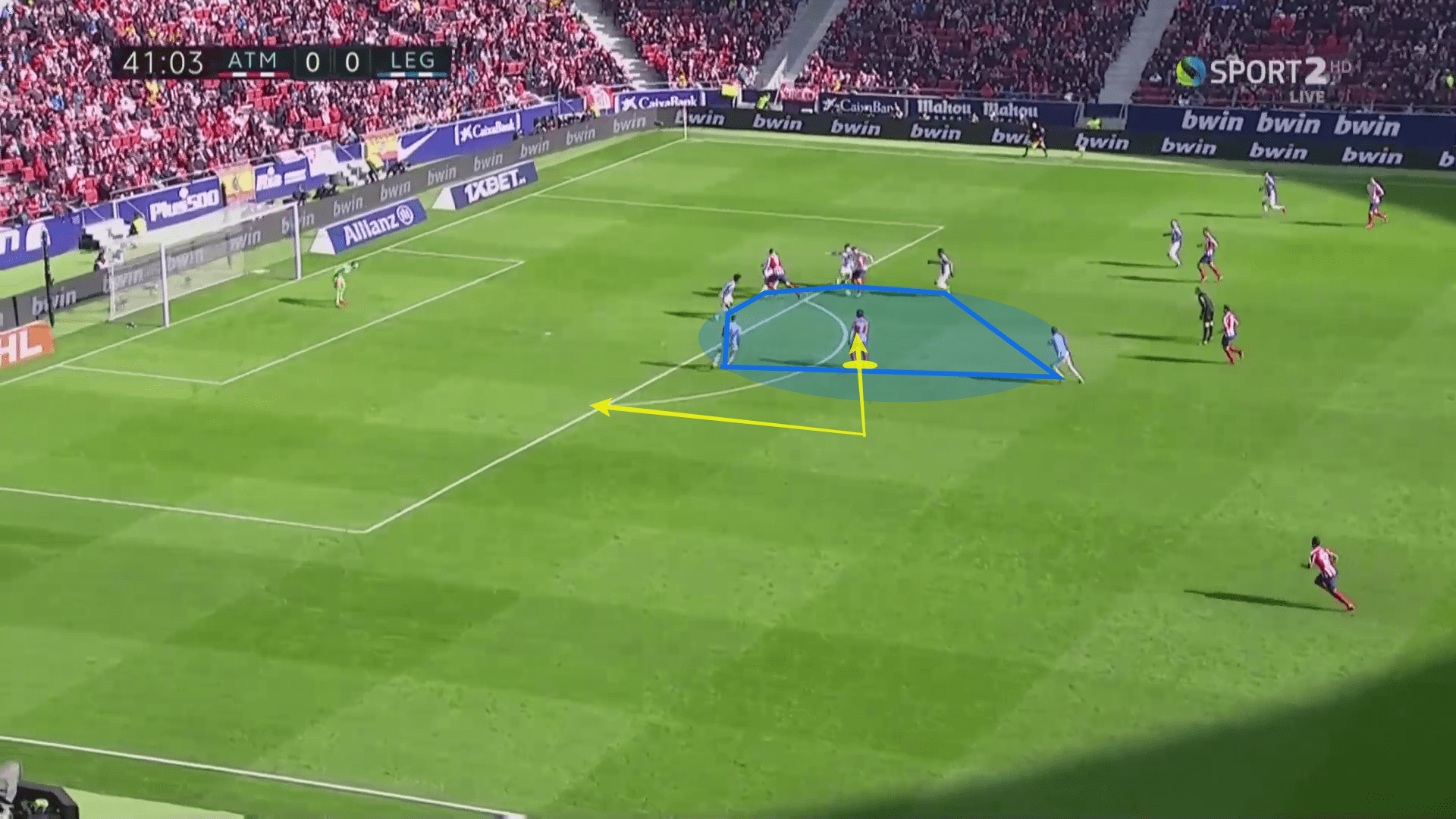
However, the issue does not end there.
As can be seen in this example against Leganés, he simply makes wrong decisions with his movement.
In crowded areas, where he is often man-marked, he fails to identify spaces to exploit and instead runs into even more crowded areas.
Félix is one of two naturally attack-minded players on the field who do have some freedom to make such movement, which is a major cause of Atlético’s frustrations in attack.
Rather than identifying gaps and stretching defences, Félix is too often guilty of being drawn centrally and in towards the ball.
That means that, without attacking wingers down the flanks, there is no reason for the opposition defence to become stretched.
As such, Atleti are easy to defend against with a narrow low block.
Félix almost plays into this system and leaves full-backs with more work to do to get forward, consequently taking more risks and demanding more of them physically.
Loss of clinicality
Perhaps the most significant change in Félix’s game has been how he has performed in front of goal.
With only four goals in his first six months of competitive action as an Atlético player, he is performing well below expectations in a side who were expecting him to come in and replace the goals of Antoine Griezmann.
He has been far from capable of doing that.
There was good reason to be optimistic too, given that at Benfica, Félix far outscored his xG.
In fact, his total of 20 goals at club level in 2018/19 was substantially more than his 13.84 xG, meaning he scored 44.5% more goals than would be expected, a figure which pits him up alongside the likes of Lionel Messi and Cristiano Ronaldo for clinicality.
This season at Atlético, he is significantly underscoring his xG of 7.37 with only four strikes.
That represents 45.8% underscoring, meaning that the overall swing is almost 100%.
It is fair to see why Simeone may feel frustrated at this significant change.
One of the most evident examples was this effort against Barcelona, where he sliced his volley which was worth 0.48 xG and the ball didn’t even go out of play.
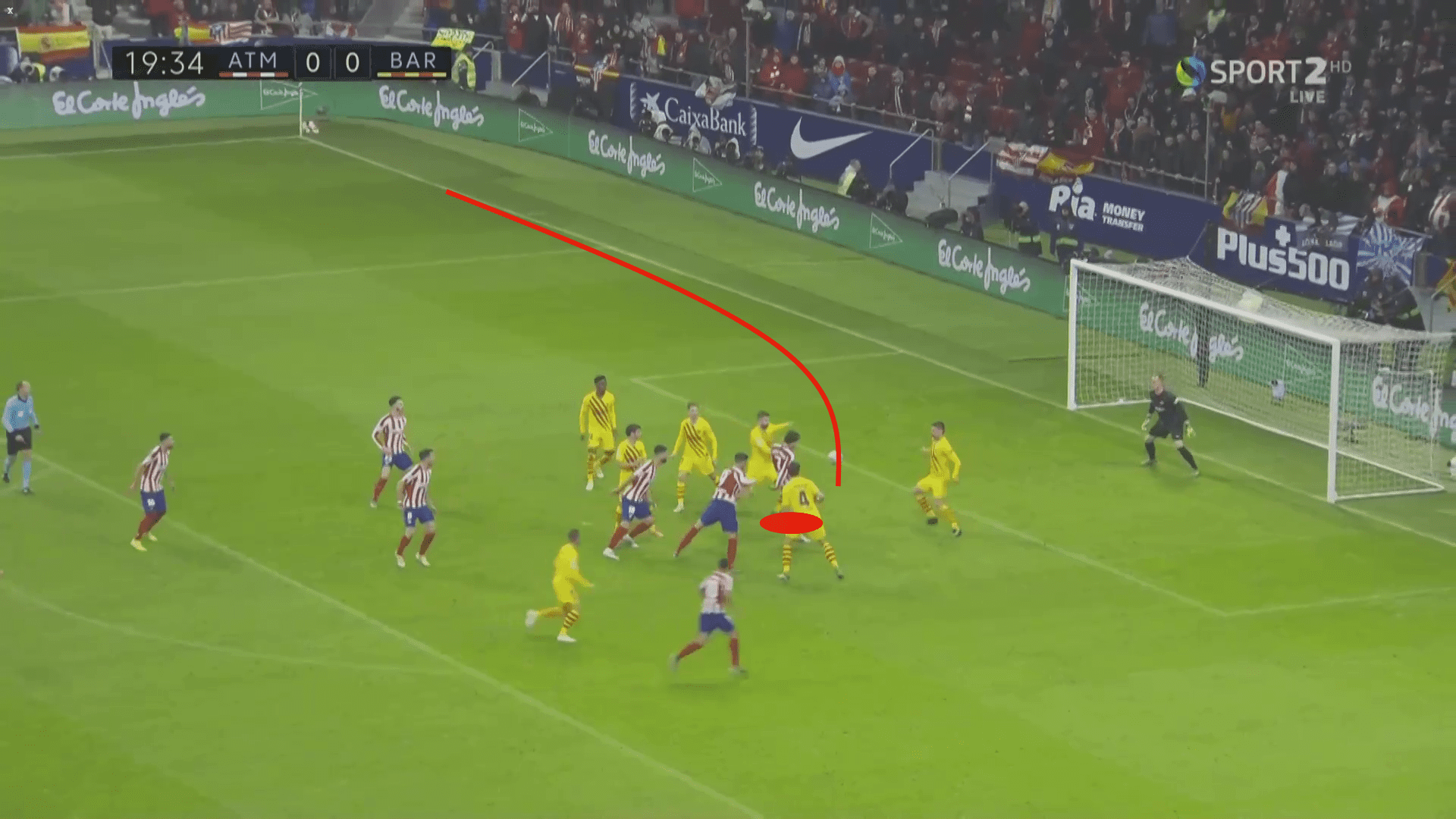
In analysing what has caused the switch, many pundits point to the added defensive responsibilities but that is simply an unjust criticism of Simeone’s style.
Whilst in 2018/19, Félix recorded an average of 2.8 shots per game, it has dropped in 2019/20 but insignificantly, only a small decrease to 2.74.
What has changed more notably is his xG per shot, which has gone from 0.15 per attempt to 0.12 per effort on goal.
While this is not a major change, it does reflect the nature of his attempts on goal.
He is taking more long shots, with his average distance per shot having increased, but also snatching at chances more.
Rather than taking his time to take another touch and get his shot away from a slightly better angle, he is rushing into shots.
This is perhaps the most notable way in which we can see how the pressure of Atlético Madrid and the big-money move is getting to Félix.
This is something that may change with time and would seemingly point to more of a temporary, form-related issue, rather than being symptomatic of a long-term concern, but it does give Simeone work to do in his management of Félix.
Injuries
The final factor which is restricting Félix’s development and adjustment is the number of injuries, mostly muscular, that he has faced since moving to the Spanish capital.
This is not a problem unique to Félix, Atlético have already had 12 muscle injuries this season, though even that is an improvement on the 22 recorded by the end of January in 2018/19.
Fitness coach “Profe” Ortega is notoriously demanding and it is widely known that the intense regime run at the club often leads to injuries and breakdowns, particularly from new signings.
Félix has been unfortunate that these injuries have disrupted his progress, but he must look to capitalise on pre-season in particular in order to build up fitness and gain a regular run of games.
EURO 2020 is unlikely to help his efforts, but succeeding at Atlético Madrid relies upon gaining the significant physical strength required to endure the intensity of not just training but Simeone’s approach in general.
Conclusion
Even after several months of analysis, it is still far too early even to consider writing off Félix as a success at Atlético Madrid.
Indeed, his early flashes of brilliance prove that he does have what it takes to bring something unique to Atlético Madrid.
However, his progress since has not kicked on and his role within Simeone’s system remains unclear.
The club is looking for a new number nine who may help the club get the most out of Félix.
The youngster’s start has not been terrible, but he would have hoped to do better in the first half of a season in Spain.
With only four goals to his name for his club, he is the star player and should be expecting more.
Should Simeone decide on his role in the side and he maintains fitness, that consistency may help him to bring out his best features.
Out wide is a role that clearly does not support him and has frustrated his movement. The consequent impact on his confidence affects his finishing.
Given his impressive technical quality, there are still plenty of reasons to be optimistic regarding Félix’s future at the Estadio Wanda Metropolitano, but in his early months, it does not seem a clear tactical fit to put him into this side.

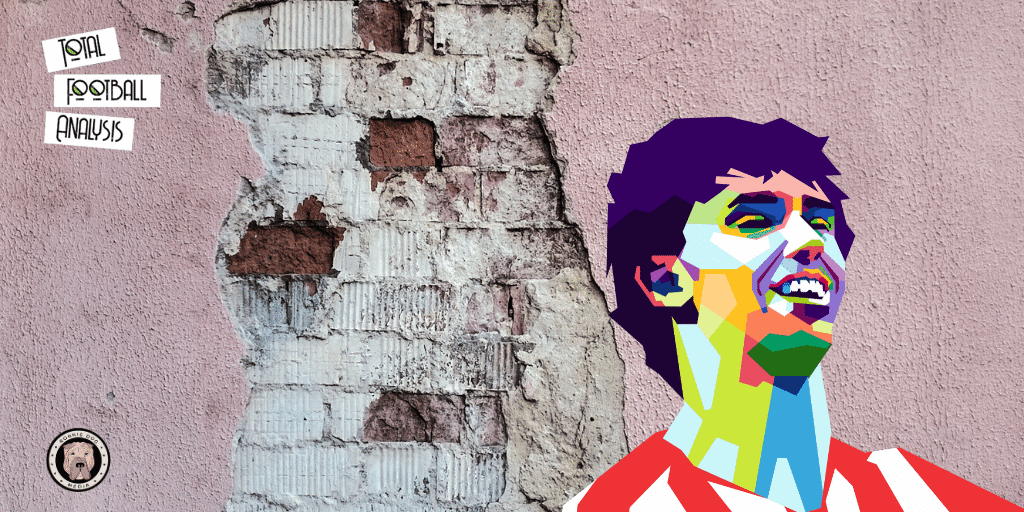



Comments